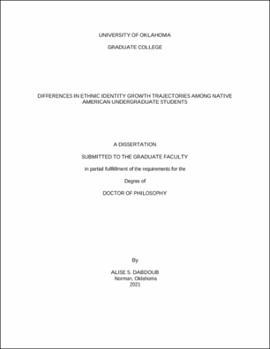| dc.contributor.advisor | Snyder, Lori | |
| dc.contributor.author | Dabdoub, Alise | |
| dc.date.accessioned | 2021-08-05T15:54:01Z | |
| dc.date.available | 2021-08-05T15:54:01Z | |
| dc.date.issued | 2021-08-05 | |
| dc.identifier.uri | https://hdl.handle.net/11244/330213 | |
| dc.description.abstract | Having a strong ethnic identity has been shown to provide positive outcomes such as helping to buffer against discrimination, ease culturally related anxiety, and increase academic achievement (Altschul, Oyserman, & Bybee, 2006; Lee, 2003; McNeil, Kee, & Zvolensky, 1999). Research has demonstrated that college can serve as a transition point that encourages exploration and development of one’s ethnic identity (Syed & Azmitia, 2009). This may be especially critical for Native American college students given the subjugative history between the U.S. government, institutions of higher education, and Tribal Nations. Thus, it is important to examine how Native American ethnic identity interacts with the climate of universities. Therefore, this study examined changes in Native American students’ ethnic identity over the course of their college careers. In addition, this study probed how immersion in both tribal and campus culture affected ethnic identity for these students. Lastly, markers of academic success (GPA and persistence rate) were assessed in relation to students’ ethnic identity levels. Results revealed three distinct ethnic identity trajectories with low, moderate, and high intercepts. These trajectories did not change over the course of college. Those with high ethnic identity trajectories demonstrated higher levels of campus comfort and better experiences with faculty than those low in ethnic identity group, indicating membership in supportive campus communities. However, those with high ethnic identity levels also reported poorer race-based interactions on campus and in classrooms. They also reported higher levels of discrimination and stress due to pressures associated with being Native American, and ultimately lower GPAs than those with lower ethnic identity trajectories. Persistence rate did not differ by ethnic identity level. | en_US |
| dc.language | en_US | en_US |
| dc.subject | Native American Ethnic Identity | en_US |
| dc.subject | Native American College Experience | en_US |
| dc.subject | Differences in College Experience by Ethnic Identity Level | en_US |
| dc.subject | Latent Class Growth Analysis | en_US |
| dc.title | Differences in ethnic identity growth trajectories among Native American undergraduate students | en_US |
| dc.contributor.committeeMember | Youngbull, Natalie | |
| dc.contributor.committeeMember | Shane, Connelly | |
| dc.contributor.committeeMember | Jorge, Mendoza | |
| dc.contributor.committeeMember | Lara, Mayeux | |
| dc.date.manuscript | 2021-07-27 | |
| dc.thesis.degree | Ph.D. | en_US |
| ou.group | College of Arts and Sciences::Department of Psychology | en_US |
